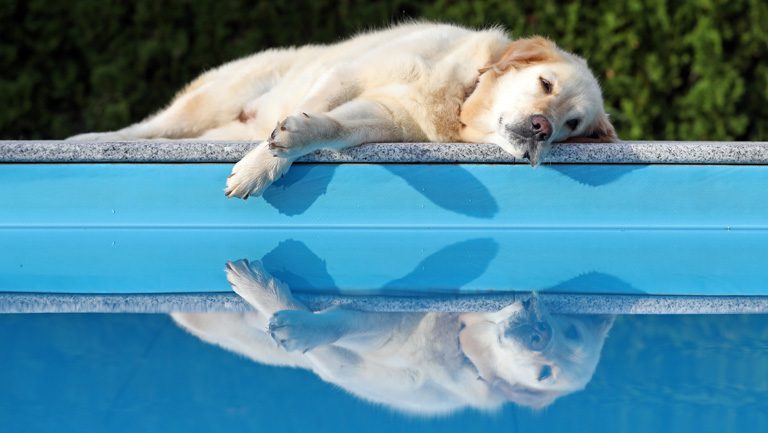Safety is often at the forefront of pool owners’ minds as far as humans are concerned, but what about their pets? An estimated 5,000 family pets drown in backyard swimming pools annually. With awareness and a little prevention, such tragedies can easily be thwarted.
Swimming Lessons
It may seem simple, but make sure your dog can swim. It’s a common misconception that all dogs can “doggie paddle.” Just as is the case with humans, some dogs are more athletic than others. Also, a dog’s breed is a major factor in how well it takes to water. Breeds with broad chests and short legs (i.e., bulldogs, corgis, basset hounds, and pugs) as well as heavily-muscled “bully breeds” may find it more difficult to swim.
Start by giving your dog a simple “swimming lesson,” incorporating a well-fitting life jacket to improve buoyancy and bolster confidence. While in the pool with the dog, support his/her back end as he/she swims a short distance. This will teach your pup to effectively use their back legs for propulsion, keeping them afloat.
Watch & Limit Activity
Once your dog has learned how to navigate the pool, make sure to watch them carefully and make sure they don’t overdo it. Be vigilant for signs of fatigue, including when their rear end starts to sink too low in the water while swimming. Tired dogs can also become over-stimulated, which is often signified by a wide-eyed, frenetic pace.
Even in the water, dogs can easily overheat, as they have no way to disperse heat other than panting. Once a dog starts panting, owners should check the color of its gums and tongue, comparing what they see to what is “normal” for their dog when at rest. A darker pink color usually means it’s time to take a break. Be sure to watch for signs of heat stroke, which include staggering, excessive drooling, and an overall “drunken” appearance. As with humans, during times of excessive heat – and especially if exercise is involved – it’s best to avoid direct sunlight between 10 a.m. and 4 p.m.
Exit Strategy
Equally as important as learning how to stay afloat in the pool successfully is learning how to get out of the pool successfully. Teach your dog to utilize the step area as the only point of access for entering and exiting the pool, reinforcing training with treats, petting, and lots of praise. An easily-spotted visual, such as a large potted plant placed near the steps, can be helpful in aiding the dog to orient itself and find its way out. Toy breeds may benefit from a landscaping brick placed on the top pool step, making their climb in and out shorter.
Safety Products
Add-ons like fences, safety pool covers, or pool alarms can be invaluable layers of pool protection for pet owners. Simply stated, a pool alarm is a device installed in or around the pool that triggers a very loud alarm if an object greater than a certain weight enters the water. Similarly, Safety Turtle is a collar that sounds a very loud alarm if submerged. For pools without an easily-accessible/easy-to-use exit, the Skamper-Ramp is a pool accessory that can be a life-saver for both pets and wildlife. As previously mentioned, a properly-fitting life jacket is a great safety tool to incorporate into your dog’s swim sessions.
Know Pet CPR
Just in case the worst happens, it is recommended that pet owners be prepared by knowing pet CPR. CPR should only be performed when absolutely necessary, as the procedure can be hazardous and cause physical complications or fatal damage if performed on a healthy pet. For more information on pet CPR and a diagram from the American Red Cross, please click here, or consult your pet’s veterinarian.
Providing pool and home improvement financing solutions since 1979, Lyon Financial loves family pets… and keeping them happy and healthy. We also love the difference we can make for your family by providing something that puts years of memories within reach. Call 877-754-5966 for more information about installing your corner of paradise.




